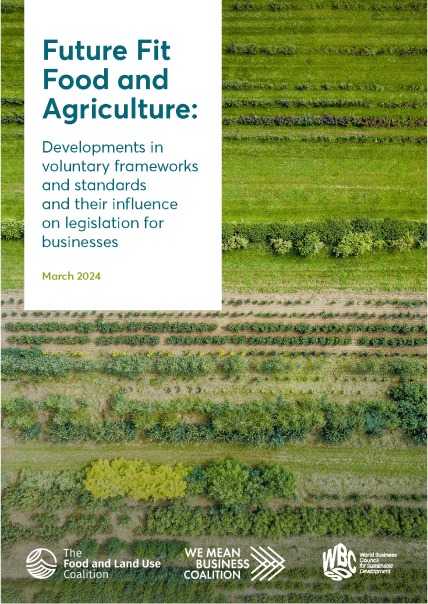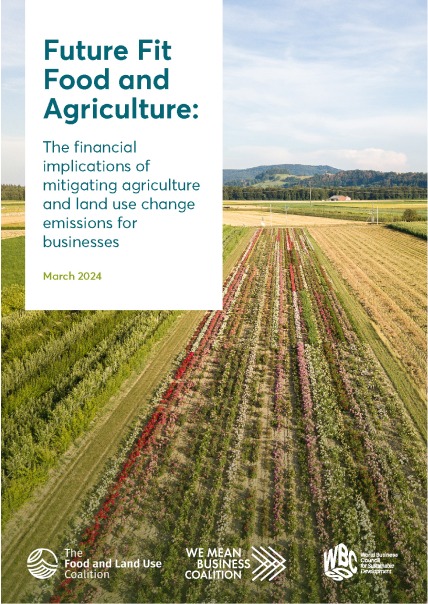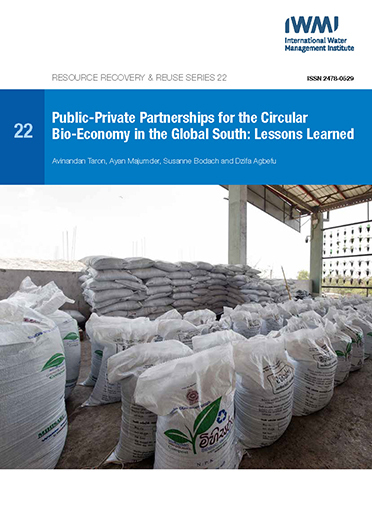AgriFoodTech Investment
AgFunder (2023) Africa AgriFoodTech Investment Report 2023 # 56 p.- AgFunderNews reports on the evolution of the global food and agriculture system.
- By going beyond the headlines, it analyze the people, companies and technologies aiming to improve human and planetary health.
- See: Timbuctoo : Linking agricultural innovation to start-up accelerators
AU (2024) 4th CAADP Biennial Review Report 2012-2023 #170 p
- The Fourth CAADP Biennial Review (BR) reporting cycle has benefited from the overall coordination of AUC Department of Agriculture, Rural Development, Blue Economy and Sustainable Environment (DARBE) and AUDA-NEPAD throughout the process.
- See: 8 March 2024 Official Launch of the 4th BR Report and Post Malabo Agenda Roadmap
FOLU (2024)  The financial implications of mitigating agriculture and land use change emissions forbusinesses #27 p + Key Messages #3 p
The financial implications of mitigating agriculture and land use change emissions forbusinesses #27 p + Key Messages #3 p
- Investment from the food sector of approximately US $205 billion per year between 2025 and 2030 could mitigate up to 9 GtCO2e annually by 2030.
- While significant, these costs represent less than 2% of total projected food sector revenues and come with other benefits including access to new and growing markets, some on farm savings and improved supply chain resilience.
- This report highlights that the burden of mitigation varies depending on where actors sit along the value chain. A critical challenge is that the costs are currently projected to land most heavily on farmers, who are the least able to pay.
- Overcoming this inequity requires companies to reassess how they partner with actors in the value chain, particularly farmers, and how they engage with policymakers to accelerate action.

FOLU (2024) Developments in voluntary frameworks and standards and their influence on legislation for businesses #30 p + Key Messages #2 p
- Businesses setting and implementing ambitious climate and nature strategies today will be better prepared for future sustainability regulation, facing fewer compliance risks and experiencing less disruption in their supply chains.
- Ambitious companies can not only leverage established and emerging voluntary standards to get ahead of the game, but they can and should also seize the opportunity to advocate for harmonized standards and regulation, which will accelerate the food sector’s transition to a sustainable future.
- Related:11 April 2024. 03:00pm - 04:15pm How Can Businesses Secure a More Sustainable, Equitable and Resilient Future for the Food Sector?
AEF (2023) Realising the full potential of carbon pricing and markets: Opportunities for the Africa-Europe Partnership # 33p.
- In the framework of COP28 (the UN Climate Change Conference), the Africa-Europe Foundation (AEF) and the Climate Action Platform for Africa (CAP-A) released a joint report, outlining the reasons why carbon pricing and subsequent trading is a win-win opportunity to advance global climate action and achieve socio-economic growth.
OGL (2023) International development in a contested world: endingextreme poverty and tackling climate change A White Paper on International Development November 2023, #155 p.- This White Paper sets out a re-energised international development agenda, for the UK, working with its partners, based (among others) on the following priorities: going further, faster to mobilise international finance to end extreme poverty, tackle climate change and biodiversity loss, power sustainable growth and increase private sector investment in development
- (page 55) Established in Nairobi in 2012 by the UK, FSD Africa is a specialist development agency working across more than 30 African countries to address challenges stopping finance getting to where it is most needed.
- The Fourth CAADP Biennial Review (BR) reporting cycle has benefited from the overall coordination of AUC Department of Agriculture, Rural Development, Blue Economy and Sustainable Environment (DARBE) and AUDA-NEPAD throughout the process.
- See: 8 March 2024 Official Launch of the 4th BR Report and Post Malabo Agenda Roadmap
 The financial implications of mitigating agriculture and land use change emissions forbusinesses #27 p + Key Messages #3 p
The financial implications of mitigating agriculture and land use change emissions forbusinesses #27 p + Key Messages #3 p- Investment from the food sector of approximately US $205 billion per year between 2025 and 2030 could mitigate up to 9 GtCO2e annually by 2030.
- While significant, these costs represent less than 2% of total projected food sector revenues and come with other benefits including access to new and growing markets, some on farm savings and improved supply chain resilience.
- This report highlights that the burden of mitigation varies depending on where actors sit along the value chain. A critical challenge is that the costs are currently projected to land most heavily on farmers, who are the least able to pay.
- Overcoming this inequity requires companies to reassess how they partner with actors in the value chain, particularly farmers, and how they engage with policymakers to accelerate action.

FOLU (2024) Developments in voluntary frameworks and standards and their influence on legislation for businesses #30 p + Key Messages #2 p
- Businesses setting and implementing ambitious climate and nature strategies today will be better prepared for future sustainability regulation, facing fewer compliance risks and experiencing less disruption in their supply chains.
- Ambitious companies can not only leverage established and emerging voluntary standards to get ahead of the game, but they can and should also seize the opportunity to advocate for harmonized standards and regulation, which will accelerate the food sector’s transition to a sustainable future.
- Related:11 April 2024. 03:00pm - 04:15pm How Can Businesses Secure a More Sustainable, Equitable and Resilient Future for the Food Sector?
- In the framework of COP28 (the UN Climate Change Conference), the Africa-Europe Foundation (AEF) and the Climate Action Platform for Africa (CAP-A) released a joint report, outlining the reasons why carbon pricing and subsequent trading is a win-win opportunity to advance global climate action and achieve socio-economic growth.
Food systems
workplace policies and gender equality in 51 global food system organizations #30 p
- For the first time, the 2023/2024 Report expands its focus to address a policy area that plays a decisive role in promoting equality of opportunity in the workplace: the extent to which workplace policies recognize and support employees’ care responsibilities.
- The data reveal policy attention to parental leave, but other policies related to family needs, such as child care and elder care, remain scarce.
- Gender- and equity-related policies and practices global food system organizations Recorded
Keith O. Fuglie , Ruben G. Echeverria (2024) The economic impact of CGIAR-related crop technologies on agricultural productivity in developing countries, 1961–2020 #21 p.
- This article highlights the diffusion and productivity impact of CGIAR crop research. The report shows that by 2020 , CGIAR-related crop technologies were adopted on at least 221 million hectares across Asia, Africa, and Latin America.
IDRC (2024) Transforming food systems through policy change. Policy brief bundle # 2 p.
- There is increasing evidence for the need to develop effective ‘double-duty policy bundles’ (DDPBs), which can enable more nutritious diets and effectively tackle under- and over-nutrition.
- To achieve food systems change, DDPBs integrate nutrition- and healthsensitive policies within broader strategies (e.g. environmental and agricultural policies).
- Webinar: 28 March 2024. Transforming Africa’s food future: Policy changes for healthier food systems
IWMI (2023) Public-private partnerships for the circular bio-economy in the Global South: lessons learned. CGIAR Research Program on Water, Land and Ecosystems (WLE) #33p.
- See: The Resource Recovery and Reuse publication series IWMI
- Webinar: 27 March Overcoming barriers to building the circular bioeconomy
Nutrition
- In this fifth fact sheet of the series, ACB delves into the complexity of some of these socioeconomic inequities and argue that these are being perversely exploited by the ultra-processed food (UPF) giants to drive the purchase and consumption of UPF in Africa.
- This is overlayed by the changing socio- and politico-economic conditions, which provide further market opportunities for UPF as more accessible, affordable, and desirable food options in both urban and rural contexts.
FAO, FARA (2024) Compendium of forgotten foods in Africa # 120 p
- This new Compendium is a first-of-its-kind comprehensive collection of 100 African forgotten food crops.
- See: 27 March 2024. Virtual session at FAO to discuss pressing technical issues related to food security and nutrition on the continent.
VACS (2024) Vision for Adapted Crops and Soils (VACS) Research in Action #37 p.
- This report outlines the guiding concepts of the VACS approach, provides an overview of the research conducted as part of VACS through crop-modeling and evidence synthesis approaches, and recommends areas of focus for the movement going forward as well as ways to engage in VACS.
- 14 March 2024. African Opportunity Crops: nutritious and climate resilient. Recorded
- Upcoming: 23 April 2024. VACS Community of Practice Webinar: Optimizing the Vision for Adapted Crops and Soils - Hosted by FARA
Agrocology
FAO (2024) Outcome Brief: National Agroecology Strategies in Eastern and Southern Africa - Lighthouses for food system transformation #52 p- Following a three-day peer-to-peer exchange with policymakers and shapers on the National Agroecology Strategies (NAS), which took place in Nairobi in October 2023, the Biovision Foundation has recently published an outcome brief at a joint event with FAO and Agroecology Coalition. This brief shares insights on the NAS processes in Kenya, Tanzania, Uganda, and Zambia, outlining five main reasons why governments should opt for NAS today and serve as a unique opportunity to learn from policy developments in Eastern and Southern Africa.
- These strategies have the potential to harness opportunities of a sustainable development of agri-food systems, by upscaling agroecological production practices, developing markets, value chains and consumer demand that can accelerate transition.
Climate adaptation
- This paper outlines the most promising ways for research and philanthropic organizations to engage with the private sector to develop innovations that support the transition to a more sustainable food system.
- It explores how the private sector research and development pipeline for food and agriculture works, how it currently aligns to the need for climate action, the hurdles (“lock-ins”) involved in making it more climate responsive, and how to overcome them with a series of interventions (“lockpicks”).
Trade
African case studies of the Making Agricultural Trade Sustainable project
- Reducing poverty among smallholder farmers through enhanced trade regimes and value chains for coffee in Uganda and Tanzania - Improving the livelihoods of smallholder farmers through trade and food value chains; localisation of food systems, strengthening of territorial markets - Uganda, Tanzania
- Priority Intervention Requirements to Enhance the Capacity of Sub Saharan African (SSA) Countries to Improve the Volume and Quality of Agri-food Exports -The cases of Tanzania, Ethiopia, Uganda, and Ghana - Standards and market access; challenges related to WTO Rules and Regulations and/or EU requirements; strengthening of territorial markets - Sub-Saharan Africa
- Role of policy frameworks and social cohesion for sustainable value chains and livelihoods in Ghana - Emerging markets; poultry chains; role of policy regulation regarding animal welfare, inputs and trade; competitiveness, sustainability, livelihoods - Ghana
- Analysis of cocoa and chocolate purchasing practices that could undermine living incomes for cocoa farmers - Experiences, obstacles, impact and lessons learned from a multistakeholder initiative on sustainability standards in the cacao sector - EU, Côte d’Ivoire
- Impacts of EU policies on local dairy value chains in West Africa - EU agricultural, trade, investment and development policies; impact on the development of local, fair and sustainable dairy chains - EU, Africa
- Increase of productivity and farm size, if applied to the existing number of farms, would allow Algeria to become self-sufficient in milk production under current market conditions.
- Human rights due diligence in the coffee value chain - Integrating human rights and environmental due diligence in coffee chains; impact on production practices and smallholder farmers
- Private standards and sustainable trade - Impact of processors/retailers' standards on development of local, fair, sustainable food chains Kenya
- Ethical trade initiatives in the South African wine industry - Assessment of local and global ethical trade programmes in South Africa (e.g. Fair Trade, Ethical Trading Initiative, Ethical Trade Association) South Africa
- Free Trade Agreements between the EU and selected North African countries, and their impact on food systems, access to water and sustainable development
Digital agriculture
- The report analyses 72 FAO activities and projects in Africa, spanning various agricultural subsectors and sub-regions, and how they harnessed digitalization. It highlights where more investment is needed from FAO and others.
- Two sets of recommendations are made: the first centres around how generally to better leverage digital technologies for food security and food system transformation in Africa. The second articulates around how FAO may strengthen the integration of digitalization in its Africa programme priorities.
EC publications
See: 18 - 21 March 2024. European Research and Innovation Days are part of the R&I Week Recorded
EC (2024) Building the future with nature: Boosting Biotechnology and Biomanufacturing in theEU #21 p.
- The Commission has proposed a series of targeted actions to boost biotechnology and biomanufacturing in the EU.
- The advances in life sciences, supported by digitalisation and artificial intelligence (AI), and the potential of solutions based on biology to solve societal issues, make biotechnology and biomanufacturing one of the most promising technological areas of this century.
- They can help the EU to modernise its agriculture, forestry, energy, food and feed sectors and industry. In addition, these technologies can contribute to a more competitive and resilient EU, that provides better healthcare to its citizens, and succeeds in its green and digital transitions. Find more online.
- The agri-food ecosystem is one of the 14 key industrial ecosystems identified in the EU's Industrial Strategy. This strategy announced the co-creation of transition pathways with stakeholders to help accelerate the green and digital transition. This collaborative effort aims to build on existing strategies and enable their implementation by providing concrete actions. These actions aim to reinforce commitments by relevant actors towards the sustainability, digitalisation and resilience of the ecosystem.
EC/DG RI (2024) Food 2030: Green and resilient food systems - conference outcome report #45 p.
- In December 2023, over 400 people from the Food 2030 community convened in Brussels to attend the high-level conference “Food 2030: Green and resilient food systems”, and over a thousand more followed it online.
- See PAEPARD blogpost Food 2030: Green and resilient food systems - conference
EC/DG RI (2024) Valorisation policies – Code of practice on industry-academia co-creation – Commission recommendation, Publications Office of the European Union # 2p.
The Code of Practice on industry-academia provides practical guidance for creating successful partnerships for knowledge valorisation. It calls for promoting co-creation in the organisation’s strategy, investing in skills, networking, communication, and awareness raising. It stresses the importance of creating incentives and strengthening the role of intermediaries and joint infrastructures in translating research results into business applications.
The Code of Practice on citizen engagement offers practical guidance to strengthen links between research entities and societal actors for better uptake of research results. It identifies the need for a strategic approach at the organisation level which encourage cross-sector collaboration, awareness raising and strengthening the role of intermediaries.
- It also proposes the use of incentives, co-creation tools and digital solutions with a human-centric and sustainable design.












No comments:
Post a Comment